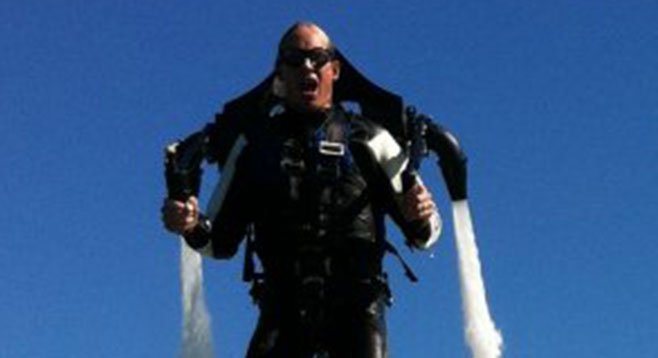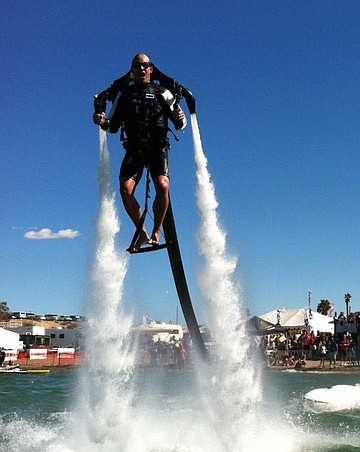 Facebook
Facebook
 X
X
 Instagram
Instagram
 TikTok
TikTok
 Youtube
Youtube

‘I’m gonna make your dreams come true,” I said to Patrick. “Well, the dreams you had about flying after you saw The Rocketeer, anyway.”
It was over 20 years ago, but something about the diesel-punk superhero has stayed with him. A man with a rocket on his back was just plausible enough, I guess. So now that he’s firmly entrenched in the middle-aged lookback on his lost youth, I’m sending him to Jetpack America at the Mission Bay Sports Center (888-553-6471; jetpackamerica.com).

“When I first saw the jetpack,” said Jetpack America instructor Morgan West, “and even when I first flew it, I kept saying to myself, Is this for real? Nothing compares to it: not snow skiing, water skiing, parasailing, or even skydiving. The pack was invented by Raymond Li; he was inspired by the James Bond movie Thunderball, and it took him 12 years to develop it. It’s basically a water-powered flying jetpack. The pack is connected to a hose, which is connected to a pod, something like the hull of a jet ski. Inside the pod is the pump, the fuel, and the electronics — the brains and brawn of the jetpack. Instead of pumping water back like a regular jet ski, it pumps it out the pack on your back. That gives you lift, and also the ability to steer.”
Yes, says West, it’s safe. “You have a life jacket on, of course. And the pack itself is made of buoyant carbon fiber. So there’s no danger of sinking. And there’s someone on a jet ski out there with you, a lead pilot to help keep you away from boats (and take video). Plus, you have the instructor on the shore.”
And before you get in the water, you do your prelims. “First, we have you watch a training video that shows you how to start and stop and how to steer the jetpack. The pack is very sensitive; you use very small movements. We also emphasize the importance of always going forward and of keeping your distance from the pod. Then we hook you up to a training pack so you can practice steering techniques. After that, we head to the water and strap you into a real jetpack. You walk out into chest-deep water and you listen. You’ll be wearing a walkie-talkie helmet, and the instructor will be on shore, talking to you and helping you. If you’re not really getting the hang of it, the instructor will pop into the water and show you how to get up. When you take your first flight, the instructor will also control the throttle via remote control. As you get more comfortable with jetpack flight, the instructor will give you more throttle.”
Throttle, West emphasized, “is just how much water is being pumped through the jetpack. You control whether you are going up or forward. The throttle just dictates how high. Physically, it’s possible to go as high as 30 feet. If a first-timer is doing really well, they’ll go about 20 feet up. But the majority stay at 10 to 15 feet.” First-timers can also dive under the water, pop back up, “and start walking on the water’s surface. The space you’re in is about the size of a football field, and it’s like you’re doing laps inside that area.”
Most people, says West, making jetpacking a bucket-list activity. “For most people, I recommend the 25-minute package. That gives you a good amount of flight time; you can really say you’ve done it. But we do have monthly members, people who come back for multiple flights. That’s when it gets really, really fun, because that’s when you get control of the throttle. And that’s when you can start working on advanced maneuvers like corkscrews and backflips and high-speed donuts. You can also do hovers — you go up and hold at a specific height by your control of the throttle.”
Jetpack America is open year-round, Wednesday to Sunday. They offer three flight experiences: the 15-minute Intro Flight ($159–$199), the 25-minute Jetlev Flight ($249–$279), and the 50-minute Rock Star Flight ($549). (Lower prices apply on weekdays.) Video footage of your adventure is available for an additional fee ($79 standard, $149 premium).


‘I’m gonna make your dreams come true,” I said to Patrick. “Well, the dreams you had about flying after you saw The Rocketeer, anyway.”
It was over 20 years ago, but something about the diesel-punk superhero has stayed with him. A man with a rocket on his back was just plausible enough, I guess. So now that he’s firmly entrenched in the middle-aged lookback on his lost youth, I’m sending him to Jetpack America at the Mission Bay Sports Center (888-553-6471; jetpackamerica.com).

“When I first saw the jetpack,” said Jetpack America instructor Morgan West, “and even when I first flew it, I kept saying to myself, Is this for real? Nothing compares to it: not snow skiing, water skiing, parasailing, or even skydiving. The pack was invented by Raymond Li; he was inspired by the James Bond movie Thunderball, and it took him 12 years to develop it. It’s basically a water-powered flying jetpack. The pack is connected to a hose, which is connected to a pod, something like the hull of a jet ski. Inside the pod is the pump, the fuel, and the electronics — the brains and brawn of the jetpack. Instead of pumping water back like a regular jet ski, it pumps it out the pack on your back. That gives you lift, and also the ability to steer.”
Yes, says West, it’s safe. “You have a life jacket on, of course. And the pack itself is made of buoyant carbon fiber. So there’s no danger of sinking. And there’s someone on a jet ski out there with you, a lead pilot to help keep you away from boats (and take video). Plus, you have the instructor on the shore.”
And before you get in the water, you do your prelims. “First, we have you watch a training video that shows you how to start and stop and how to steer the jetpack. The pack is very sensitive; you use very small movements. We also emphasize the importance of always going forward and of keeping your distance from the pod. Then we hook you up to a training pack so you can practice steering techniques. After that, we head to the water and strap you into a real jetpack. You walk out into chest-deep water and you listen. You’ll be wearing a walkie-talkie helmet, and the instructor will be on shore, talking to you and helping you. If you’re not really getting the hang of it, the instructor will pop into the water and show you how to get up. When you take your first flight, the instructor will also control the throttle via remote control. As you get more comfortable with jetpack flight, the instructor will give you more throttle.”
Throttle, West emphasized, “is just how much water is being pumped through the jetpack. You control whether you are going up or forward. The throttle just dictates how high. Physically, it’s possible to go as high as 30 feet. If a first-timer is doing really well, they’ll go about 20 feet up. But the majority stay at 10 to 15 feet.” First-timers can also dive under the water, pop back up, “and start walking on the water’s surface. The space you’re in is about the size of a football field, and it’s like you’re doing laps inside that area.”
Most people, says West, making jetpacking a bucket-list activity. “For most people, I recommend the 25-minute package. That gives you a good amount of flight time; you can really say you’ve done it. But we do have monthly members, people who come back for multiple flights. That’s when it gets really, really fun, because that’s when you get control of the throttle. And that’s when you can start working on advanced maneuvers like corkscrews and backflips and high-speed donuts. You can also do hovers — you go up and hold at a specific height by your control of the throttle.”
Jetpack America is open year-round, Wednesday to Sunday. They offer three flight experiences: the 15-minute Intro Flight ($159–$199), the 25-minute Jetlev Flight ($249–$279), and the 50-minute Rock Star Flight ($549). (Lower prices apply on weekdays.) Video footage of your adventure is available for an additional fee ($79 standard, $149 premium).
Comments